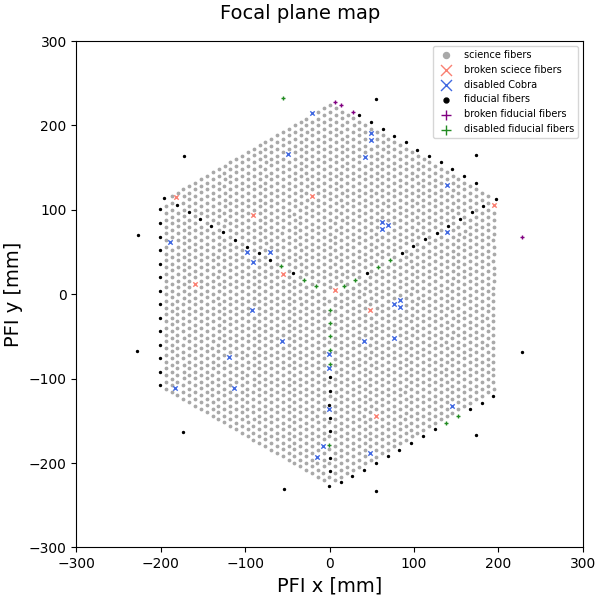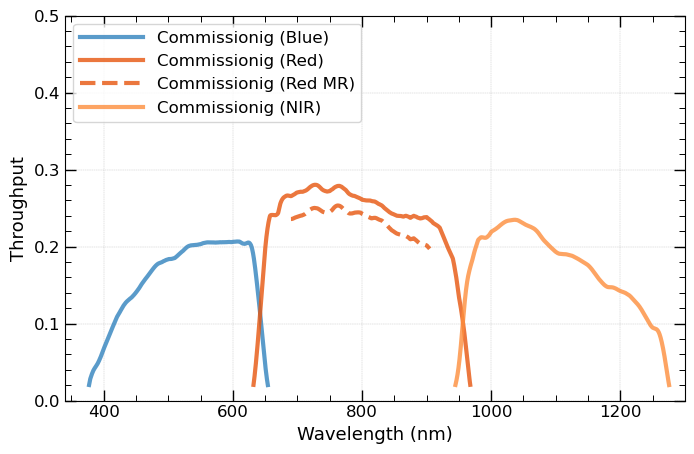Instrument
Overview

The PFS instrument consists of several components. See also here.
Wide Field Corrector (WFC)
The WFC is an optical system consisting of 7 lenses designed to correct imaging aberrations for Hyper Suprime-Cam (HSC) and PFS. The largest lens has an effective area of 820 mm (32 inch) in diameter and the total lens system is 1845 mm (73 inch) long.
Prime Focus Instrument (PFI)
Together with the WFC, the Prime Focus Instrument (PFI) is installed on the prime focus of the Subaru telescope.
At the focal plane, ~2400 fibers are paved across the ∼1.25 deg2, hexagonal-shaped field of view. There are two types of fibers, 2394 science fibers and 96 fiducial fibers. Each science fiber is attached to a small actuator, the fiber positioner (see below), and moved to the location of the targets on the focal plane. The fiducial fibers are fixed in their position and used as position reference when the science fibers are moved. The fibers are equipped with a microlens on their surface to make the F-ratio slower (F/2.8) and reduce degradation of image quality after passing through the long fiber cable.
A ∼54mm-thick glass plate, the so-called field element, is installed in front of the fibers to achieve the same image quality as HSC. The field element has opaque dots to hide the fibers behind them and shut the light coming to the fibers. By doing so, more sparse spectra can be taken by the spectrograph, which enables better understanding of the spectra on the detectors.
Surrounding the hexagonal shaped field of view, six imaging cameras are accommodated for sky-field acquisition and auto guiding. Six calibrations lamps (one quartz lamp for continuum and five arc lamps, Kr, Ar, Ne, Xe, and HgCd) are installed on the top of PFI to uniformly illuminate the screen on the dome ceiling.
Fiber Positioner ("Cobra")
Each science fiber tip is controllable in-plane by the fiber positioner, nicknamed "Cobra", which is a piezo actuator with two rotational axes. The fibers are arranged in a hexagonal pattern with 8mm separation, with each fiber being able to cover a region of 9.5mm in diameter. The overlap between adjacent regions enables 100% sky coverage within the hexagonal field.
Focal plane map
Fiber distribution on the PFI focal plane highlighting the broken/disabled fibers. See the legend for details.

Limitation of Rotator driving range and dead zone
PFS has a constraint in the range of the rotator angle, InsRot < -174.0 deg, and > 174.0 deg, that is, +/-6 deg from 180 deg. We call it the dead zone. The dead zone causes blind regions on the sky, which varies depending on POpt2's position angle.
The figures show the blind zone with black shadow on sky with Position Angle (PA) = 0.0, -90, +90, and 180 degrees.

Spectrograph System (SpS)
The four identical spectrograph modules provide the simultaneous measurement of ∼2400 spectra. Each spectrograph module has three independent channels (blue, red, and near-infrared) separated by two dichroic mirrors so that the whole system can cover a wide wavelength range from 0.38μm to 1.26μm in one exposure. Resolution is low (∼2300-4300) using a Volume Phase Holographic (VPH) grating. By switching the VPH grating, the red channel can operate in medium resolution mode (∼5000).
The Spectrograph modules also have a system to back-illuminate all ~2400 science fibers to position the fibers on the Subaru prime focal plane. The Spectrograph modules are accommodated in a dedicated clean room on the forth floor of the Subaru dome building. In the clean room, the temperature is controlled at 5±1 °C to minimize the thermal effect on optics and mechanics.
Constraints on exposure time
The maximum exposure time for a single exposure is 900 seconds for both Classical and ToO mode observations. Even if a single fiber design is to be observed for a long duration, the fibers must be re-positioned approximately every 30 minutes. Therefore, integrations for a single fiber design should be carried out as follows:
- For T_total <= 1800 seconds: two exposures of T_total/2 each
- For 1800 seconds < T_total ≤ 3600 seconds: two sets of exposures, each with two exposures of T_total/4 (with fiber repositioning between the two sets)
- For T_total > 3600 seconds: repeat exposures of 2 × 900 seconds, with repositioning between each set
Ensure this is considered when preparing the target list and estimating the expected SNR using the ETC.
Fiber System
The fiber system consists of ∼2400 optical fibers which relay light collected at the focal plane to the four spectrographs located in the clean room. A fiber cable consists of three parts, to develop and operate the instrument easily. The first part is accommodated within PFI as fiber modules with their "Cobra" positioners, one part is integrated to SpS as fiber slit assembly, and the third part is developed as long fiber cable routed on the telescope and in the dome building. The total length of each fiber is 65 meters, assembled into four groups providing 600 inputs to each spectrograph. In addition to the ∼2400 science fibers, the monitoring fibers are accommodated to check connection at installation.
Metrology Camera System (MCS)
The MCS is attached to the Cassegrain Focus of Subaru telescope and measures the positions of the fibers on the prime focus. MCS can take an image of all ∼2400 fibers in a single exposure using a large format (8960 pixels x 5778 pixels) CMOS camera. The primary mirror of MCS is 380mm in diameter to average out the local surface error of WFC.
Basic instrument parameters
Prime Focus Instrument (PFI)
| Item | Description |
|---|---|
| Field of view | ∼1.38 deg (hexagonal - diameter of circumscribed circle) |
| Field of view area | ∼1.25 deg2 |
| Input F number to fiber | 2.8 |
| Fiber core diameter 1 | 127 μm (1.12 arcsec at the FoV center, 1.02 arcsec at the edge) |
| Positioner pitch | 8 mm (90.4 arcsec at the FoV center, 82.4 arcsec at the edge) |
| Positioner patrol field | 9.5 mm diameter (107.4 arcsec at the FoV center, 97.9 arcsec at the edge) |
| Fiber minimum separation 2 | ∼30 arcsec |
| Fiber configuration time | ∼130 s |
| Number of fibers 3 | Science fibers 2386 (2394), Fiducial fibers 92 (96) |
| Fiber density | ∼2000 deg-2 / ∼0.6 arcmin-2 |
| Number of A&G camera 4 | 6 |
| Field of view of A&G camera | ∼5.1 arcmin2 per one camera |
| Sensitivity of A&G camera | gaia ∼21.7 AB mag for S/N∼5 in 5 second exposure |
- This is a diameter of the sky projected on to the fiber core not directly but through a microlens with a magnification of 1.28. According to the plate scale without microlens, 100μm subtends ∼1.1 arcsec on the sky.
- The minimum separation includes a physical limitation and a margin for collision avoidance.
- Excluding the broken fibers. Number in parentheses is from the design.
- The A&G cameras are mounted surrounding the hexagonal shaped array of fiber positioners.
Spectrograph System (SpS)
| Blue | Red (Low res.) | Red (Med res.) | NIR | |
|---|---|---|---|---|
| Spectral coverage | 380 - 650 nm | 630 - 970 nm | 710 - 885 nm | 940 - 1260 nm |
| Dispersion | ∼0.7 Å/pix | ∼0.9 Å/pix | ∼0.4 Å/pix | ∼0.8 Å/pix |
| Spectral resolution | ∼2.1 Å | ∼2.7 Å | ∼1.6 Å | ∼2.4 Å |
| Resolving power | ∼2500 (@500nm) | ∼3000 (@800nm) | ∼5500 (@800nm) | ∼4500 (@1100nm) |
| Spectrograph throughput 4 | ∼49% (@500nm) | ∼52% (@800nm) | ∼48% (@800nm) | ∼39% (@1100nm) |
System efficiency

PFS system efficiency was measured with calibration standard stars in the engineering observations. The result is plotted in the figure above. The system efficiency here includes throughput of the telescope primary mirror, WFC, fiber systems, and spectrograph optics, and detector QE. Note that the fiber aperture effect, i.e., the fraction of light covered by fiber aperture, and the vignetting effects on FoV at the primary focus of the telescope and on the SpS detectors are not included.
Typical system efficiencies in each arm are shown in the table below.
| blue (@500nm) | red (@800nm) | med. res. (@800nm) | NIR (@1100nm) | |
|---|---|---|---|---|
| Observed | ~18% | ~26% | ~25% | ~19% |
FITS header
PFS FITS header keywords
Examples of the FITS header for PFS data are accessible from the list below.
| Since | PFSA | PFSB | PFSC |
|---|---|---|---|
| 2024.05 | HeaderSample_PFSA.txt | HeaderSample_PFSB.txt | HeaderSample_PFSC.txt |
PFS instrument FITS cards
Publications
- Naoyuki Tamura et al., "Prime Focus Spectrograph (PFS) for Subaru Telescope: progressing final steps to science operation", SPIE 13096, 1309605 (2024)
- Naoyuki Tamura et al., "Prime Focus Spectrograph (PFS) for the Subaru Telescope: its start of the last development phase", SPIE 12184, 1218410 (2022)
- Shiang-Yu Wang et al., "Prime focus spectrograph (PFS) for the Subaru Telescope: the prime focus instrument", SPIE 12184, 121846R (2022
- Stephen A. Smee et al., "Performance of the near-infrared camera for the Subaru Prime Focus Spectrograph", SPIE 12184, 121847L (2022)
- Antonio Cesar de Oliveira et al., "Prime Focus Spectrograph (PFS): fiber optical cable and connector system (FOCCoS) - integration", SPIE 12184, 1218474 (2022)
- Neven Capler et al., "Prime focus spectrograph (PFS) for the Subaru Telescope: 2D modeling of the point spread function", SPIE 12184, 1218470 (2022)
- Shiang-Yu Wang, "Prime Focus Spectrograph (PFS): the metrology camera system", SPIE 11447 (2020)
- Alain Schmitt, "AMAZED: Algorithm for Massive Automated Z Evaluation and Determination", ASPC 521, 398 (2019)
- Hajime Sugai, "Prime Focus Spectrograph for the Subaru telescope: massively multiplexed optical and near-infrared fiber spectrograph", JATIS 1(3) 035001 (2015)
For more publications, please see here.